|
|
 |
|
Cyclopoida ( Order ) |
|
|
|
Corycaeidae ( Family ) |
|
|
|
Corycaeus ( Genus ) |
|
|
|
Corycaeus ( Sub-Genus ) |
|
|
| |
Corycaeus (Corycaeus) crassiusculus Dana, 1849 (F,M) | |
| | | | | | | Syn.: | Corycaeus venustus Dana, 1849; 1852 (cf. Rem. in venustus); ? Pearson, 1906 (p.34); Chatton, 1920, p.18, parasited); Oliveira, 1945 (p.191);
C. elongatus Claus, 1863 (p.157);
Corycäus danae Giesbrecht, 1891; 1892 (p.660, 673, 771, figs.F,M); Fernandes, 2008 (p.465, Tabl.2);
Corycaeus danae : Thompson, 1900 c (p.291); Thompson & Scott, 1903 (p.239, 285); Cleve, 1904 a (p.188); Carl, 1907 (p.18); Wolfenden, 1905 (1906) (p.1026); A. Scott, 1909 (p.246, Rem.); Wolfenden, 1911 (p.360); Pesta, 1913 (p.34); Wilson, 1932 a (p.359, figs.F,M); Salah & Tamas, 1970 (p.334); Salah, 1971 (p.320); Sarkar & al., 1986 (p.178); Mitra & al., 1990 (fig.3); Godhantaraman, 1994 (tab.5, 6); Rakhesh & al., 2006 (p.93, Table 2, spatial distribution); Rakhesh & al., 2008 (p.154, Table 5: abundance vs stations); Rakhesh & al., 2013 (p.7, Table 1, 4, abundance vs stations); Jagadeesan & al., 2013 (p.27, Table 3, 5, 6, fig.11, seasonal variation); Anjusha & al., 2013 (p.40, Table 3, abundance & feeding behavior);
no C. crassiusculus : Farran, 1929 (p.211, 291, fig.F);
Corycaeus crassiusculus : Böttger-Schnack, 1995 (p.92); Boxshall & Halsey, 2004 (p.494); McKinnon & al., 2008 (p.843: Tab.1); Lan Y.-C. & al., 2009 (p.1, Table 2, % vs hydrogaphic conditions); Vives & Shmeleva, 2010 (p.203, figs.F,M, Rem.); Zakaria & al., 2016 (p.1, Table 1, Rem.); El Arraj & al., 2017 (p.272, table 2); | | | | Ref.: | | | F. Dahl, 1894 (p.73); M. Dahl, 1912 (p.21, figs.F,M); Früchtl, 1924 b (p.102); Dakin & Colefax, 1933 (p.209); Farran, 1936 a (p.134, figs.F, Rem.); Mori, 1937 (1964) (p.133, figs.F,M); Dakin & Colefax, 1940 (p.111, figs.F,M); Wilson, 1942 a (p.180, Rem.); Sewell, 1947 (p.272, figs.F,M, Rem.); Chiba, 1956 (p.42, figs.M, anomalie ); Tanaka, 1957 (p.80, figs.F,M); Marques, 1958 a (p.145); Tanaka, 1960 (p.77, Rem.); Fagetti, 1962 (p.51); Motoda, 1963 (p.218, figs.F,M); Tanaka, 1964 (p.15); Chen & al., 1974 (p.54, figs.F,M); Marques, 1976 (p.1002); 1982 (p.776); Zheng & al., 1982 (p.134, figs.F); Kang & al., 1990 (p.52, figs.F,M); Chihara & Murano, 1997 (p.966, Pl.218: F,M); Boxshall, 1998 (p.221); Bradford-Grieve & al., 1999 (p.888, 974, figs.F,M); Conway & al., 2003 (p.247, figs.F,M, Rem. |  issued from : O. Tanaka in J. Fac. Agricult. Kyushu Univ., 1957, 11 (1). [Pl.3, Figs.12-15]. Female (from Japanese waters): 12, habitus (dorsal); 13, urosome (dorsolateral); 14, A2. Nota: Head and 1st thoracic segment separate. Anterior segment about 1.8 times as long as wide (18:9). Proportional lengths of cephalothorax and urosome 21:11. The abdominal segments and furca in the proportional lengths 39:24:37. Genital segment is about 2 times as long as wide (17:9), distal margin extends on the dorsal surface over the anal segment. Furcal rami about 6 times as long as it is wide at the proximal. Posterior corners of 3rd thoracic segment extend to the distal end of the genital segment. Male: 15, habitus (dorsal). Nota: Head and 1st thoracic segment fused. Proportional lengths of cephalothorax and urosome 51:31. The abdominal segments and furca in the proportional lengths 40:21:39. Genital segment about 1.5 times as long as wide (26:17). Anal segment 2 times as long as it is wide at the distal. Furcal rami about 8 times as long as it is wide at the proximal. Posterior corners of 3rd thoracic segment extend to the middle of the genital segment.
|
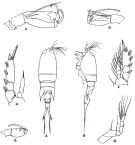 issued from : R.B.S. Sewell in The John Murray Expedition, 1933-34, Scientific Reports, VIII (1), 1947. [p.273, Fig.69]. Female (from Arabian Sea): A, habitus (dorsal); B, idem (lateral left side); C, A2; F, P1: G, P2; H, P4. Nota: Proportional lengths of the anterior and posterior regions of the body as 62 to 38. Proportional lengths of the various segments of the body (cephalon to caudal rami) as 466-483:50-63:70-80:15-26:149-166:74-93:134-136 = 1000. Genital segment more pyriform than oval (as stated by M. Dahl), and overreaches the anal segment dorsally, it is armed with a row of minute spinules along the ventral part of the posterior margin. Anal segment with the margins of the articulation of the caudal rami fringed with small spinules. Proportional lengths of the abdominal segments and the caudal rami exhibit some degree of variation. Proportional lengths of the 6 segments of A1 as 21:15:16:24:14:10 = 100. Male: D, A2; E, Mx2. Nota: Proportional lengths of the various segments of the body (cephalon to caudal rami) as 466:46:79:23:159:79:148 = 1000. 5th thoracic segment bears laterally 2 delicate setae, the shorter about half the length of the longer. The 1st abdominal segment armed ventrally on its posterior margin with a row of minute spinules. Genital aperture armed with a short spinous process on the inner side of the seta.. The 2nd abdominal segment armed with a row of spinules along the articular margin of the caudal rami. The distal end of the caudal ramus is produced xternally in a serrated crest.
|
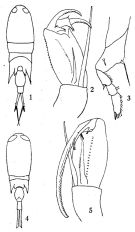 issued from : Q.-c Chen & S.-z. Zhang & C.-s. Zhu in Studia Marina Sinica, 1974, 9. [Pl.15, Figs.1-5]. Female (from China Seas): 1, habitus (dorsal); 2, A2; 3, P4. Male: 4, habitus (dorsal); 5, A2.
|
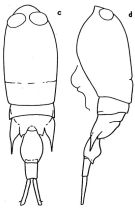 issued from : G.P. Farran in Great Barrier Reef Expedition 1928-29. Scientific Reports, V, No.3. Copepoda. 1936 [p.135, Fig.28, c, d]. Female: c, habitus (dorsal); d, idem (lateral left side). Nota: In the specimen figured the abdomen is straight, but in several others it was flexed ventrally (as shown in M. Dahl's figure, 19412).
|
 Issued from : W. Giesbrecht in Systematik und Faunistik der Pelagischen Copepoden des Golfes von Neapel und der angrenzenden Meeres-Abschnitte. – Fauna Flora Golf. Neapel, 1892. Atlas von 54 Tafeln. [Taf.51, Fig.60].As Corycäus danae. Female: 60, habitus (dorsal).
|
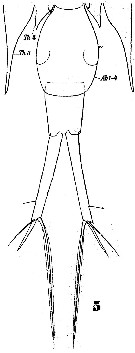 Issued from : W. Giesbrecht in Systematik und Faunistik der Pelagischen Copepoden des Golfes von Neapel und der angrenzenden Meeres-Abschnitte. – Fauna Flora Golf. Neapel, 1892. Atlas von 54 Tafeln. [Taf.51, Fig.5]. As Corycäus danae. Female: 5, urosome (dorsal).
|
 Issued from : W. Giesbrecht in Systematik und Faunistik der Pelagischen Copepoden des Golfes von Neapel und der angrenzenden Meeres-Abschnitte. – Fauna Flora Golf. Neapel, 1892. Atlas von 54 Tafeln. [Taf.51, Fig.60]. As Corycäus danae. Male: 59, habitus (dorsal).
|
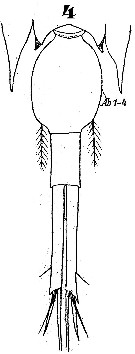 Issued from : W. Giesbrecht in Systematik und Faunistik der Pelagischen Copepoden des Golfes von Neapel und der angrenzenden Meeres-Abschnitte. – Fauna Flora Golf. Neapel, 1892. Atlas von 54 Tafeln. [Taf.51, Fig.4]. As Corycäus danae. Male: urosome (dorsal).
|
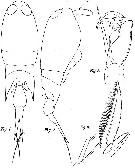 issued from : M. Dahl in Ergebnisse der Plankton-Expedition der Humboldt-Stiftung. Bd II, G. f1. I. Die Corycaeinen 1912. [Taf.III, Figs.1, 2, 3, 4]. Female: 1, habitus (dorsal); 2, idem (lateral right side); 3, A2; 4, erminal part of exopod of P2.
|
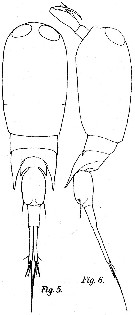 issued from : M. Dahl in Ergebnisse der Plankton-Expedition der Humboldt-Stiftung. Bd II, G. f1. I. Die Corycaeinen 1912. [Taf.III, Fis.5, 6]. Male: 5, 6]. Male: 5, habitus (dorsal); 6, idem (lateral left side).
|
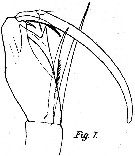 issued from : M. Dahl in Ergebnisse der Plankton-Expedition der Humboldt-Stiftung. Bd II, G. f1. I. Die Corycaeinen 1912. [Taf.III, Fig.7]. Male: 7, A2.
|
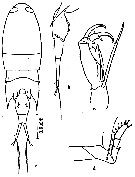 issued from : Z. Zheng, S. Li, S.J. Li & B. Chen in Marine planktonic copepods in Chinese waters. Shanghai Sc. Techn. Press, 1982 [p.135, Fig.83]. Female (from SE Korea): a, habitus (dorsal); b, urosome (lateral, left side); c, A2; d, P4. Scale bar in mm.
|
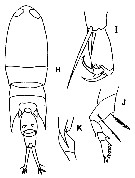 issued from : Y.S. Kang, S.-H. Huh & S.S. Lee in J. Ocanol. Soc. Korea, 1990, 25 (2). [Pl. 1, Figs.H-K]. Female (from South Korean waters): H, habitus (dorsal); I, A2; J, P4; K, genital segment (lateral). Nota: Cephalothorax 5-segmented. Lateral points of the 3rd thoracic segment extended to the end of the genital segment. Genital segment overlapped the anal segment at the dorsal margin. Caudal rami 6 times longer than wide and 2/3 the length of the urosome, rami less divergent than those of C. speciosus.
|
 issued from : Y.S. Kang, S.-H. Huh & S.S. Lee in J. Ocanol. Soc. Korea, 1990, 25 (2). [Pl. 1, Figs.L-O]. Male: L, dorsal); M, A2; N, P4; O, genital segment (lateral). Nota: Cephalothorax 3-segmented. Lateral points of the 3rd thoracic segment less slender than that of C. speciosus, and extended to 1/2 the genital segment. The distal corner of inner edge of basipod 2 of A2 less pointed out than that of C. speciosus.
|
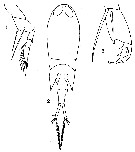 issued from : T. Mori in The Pelagic copepoda from the neighbouring waters of Japan, 1937 (1964). [Pl.75, Figs.1-3]. Female: 1, P4; 2, habitus (dorsal); 3, A2.
|
 issued from : T. Mori in The Pelagic copepoda from the neighbouring waters of Japan, 1937 (1964). [Pl.75, Figs.4-5]. Male: 4, habitus (dorsal); 5, last thoracic segment and urosome (lateral).
|
 [B & H] Female: Anal somite 1.33 times longer than wide. Genital double-somite projecting over anal somite in lateral view. Male: Anal somite more than 1.5 times longer than wide. Caudal rami as long as genital somite. [V & S] Female: Caudal rami length less than the abdominal segments (rapport ± 0.9/12). A2 with a longitudinal file of spines. Genital segment, in dorsal view, with 2 small orominences on each median part of margin. Male: Caudal rami length less than the abdominal segments (rapport ± 10/12.5). Anal segment 2 times larger than wide. 3rd thoracic points barely reaching 1/3 genital segment.
|
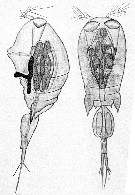 Issued from : E. Chatton in Arch. Zool. Exp. & Gen., 1920, 59, [Pl. IV, 40]. As Corycaeus venustus female (from Banyuls) parasited by Blastodinium navicula (Dinoflagellate) inside the copepod's gut.
| | | | | Compl. Ref.: | | | Sewell, 1948 (p.393, 434, 451: Rem.: p.461); C.B. Wilson, 1950 (p.193, Rem.); Chiba & al., 1957 (p.312); 1957 a (p.12); Yamazi, 1958 (p.155, Rem.); Björnberg, 1963 (p.85, Rem.); De Decker, 1964 (p.15, 21, 29); De Decker & Mombeck, 1964 (p.12); Neto & Paiva, 1966 (p.32, Table III); Delalo, 1968 (p.139); Björnberg, 1973 (p.367, 385); Palet, 1975 (p.660); Vives, 1982 (p.296); Kovalev & Shmeleva, 1982 (p.86); Dessier, 1983 (p.89, Tableau 1, 2, Rem., %); Guangshan & Honglin, 1984 (p.118, tab.); Renon, 1987 (tab.2); Dessier, 1988 (tabl.1); Hirakawa & al., 1990 (tab.3); Yoo, 1991 (tab.1); Kim & al., 1993 (p.270); Shih & Young, 1995 (p.76); Böttger-Schnack, 1996 (p.1087); Hsieh & Chiu, 1998 (tab.2); Suarez-Morales & Gasca, 1998 a (p.112); Dolganova & al., 1999 (p.13, tab.1); Ounissi & Khelifi-Touhami, 1999 (p.9, tab.II); Lo & al., 2001 (1139, tab.I); Hwang & al., 2003 (p.193, tab.2); Lan & al., 2004 (p.332, tab.1); Lo & al., 2004 (p.89, tab.1); Wang & Zuo, 2004 (p.1, Table 2, dominance, origin); Kazmi, 2004 (p.230); Hwang & al., 2006 (p.943, tabl. I); Khelifi-Touhami & al., 2007 (p.327, Table 1); Tseng L.-C. & al., 2008 (p.153, Table 2, occurrence vs geographic distribution); Tseng L.-C. & al., 2008 (p.46, table 2, abundance vs moonsons); Jitlang & al., 2008 (p.65, Table 1); Lan Y.-C. & al., 2008 (p.61, Table 1, % vs stations); Ayon & al., 2008 (p.238, Table 4: Peruvian samples); Pagano, 2009 (p.116); C.-Y. Lee & al., 2009 (p.151, Tab.2); Hernandez-Trujillo & al., 2010 (p.913, Table 2); Hsiao S.H. & al., 2011 (p.475, Appendix I); Hsiao & al., 2011 (p.317, Table 2, indicator of seasonal change); Maiphae & Sa-ardrit, 2011 (p.641, Table 2, 3, Rem.); Tseng L.-C. & al., 2011 (p.47, Table 2, occurrences vs mesh sizes); Tutasi & al., 2011 (p.791, Table 2, abundance distribution vs La Niña event);in CalCOFI regional list (MDO, Nov. 2013; M. Ohman, pers. comm.); Tseng & al., 2013 (p.507, seasonal abundance); Hwang & al., 2014 (p.43, Appendix A: seasonal abundance); Rojas-Herrera & al., 2016 (p.40, Table 2: temporal abundance); Palomares-Garcia & al., 2018 (p.178, Table 1: occurrence) | | | | NZ: | 18 + 1 doubtful | | |
|
Distribution map of Corycaeus (Corycaeus) crassiusculus by geographical zones
|
| | | | | | | | | | | | | Loc: | | | South Africa (E & W), Angola, Baia Farta, off S Ascension Is., off Mauritania, Moroccan coast, Canary Is., Rio de Janeiro, Venezuela, Cuba, Bermuda, off Woods Hole, ? W Ireland, Medit. (W Algeria, Gulf of Annaba, El Kala shelf, Lebanon Basin, Egyptian coast), Red Sea, G. of Aden, Arabian Sea, Laccadive Is., off SW Madagascar, Nosy Bé, Rodrigues Is., Seychelles, Sri Lanka, Indian, India (Saurashtra coast, S, Madras, G. of Mannar, Palk Bay, Mandarmani creek, Hooghly estuary, Kakinada Bay, Godavari region), Bay of Bengal, Christmas Is., G. of Thailand, Aru Is., Ambon Bay (Baie d'Amboine), Philippines, China Seas (Yellow Sea, East China Sea, South China Sea), Taiwan Strait, Taiwan (E, W, SW, NW, N, Mienhua Canyon, NE), S Korea, Japan Sea, Japan, Tanabe Bay, Bikini Is., Pacif. (W equatorial), Australia (Great Barrier, New South Wales, North West Cape), New Caledonia, New Zealand (Hauraki Gulf), off Hawaii, W & S Baja California (Bahia Magdalena, La Paz), Acapulco Bay, Clipperton Is., Pacif. (East equatorial), Galapagos-Ecuador, Peru, N Chile | | | | N: | 122 | | | | Lg.: | | | (11) F: 1,717-1,6; M: 1,483-1,367; (34) F: 1,7-1,68; M: 1,58; (45) F: 1,75-1,65; M: 1,4-1,3; (46) F: 1,72-1,65; M: 1,37; (66) F: 1,8-1,72; M: 1,41; (84) F: 1,66-1,59; M: 1,45; (91) F: ±1,9; M: ±1,5; (104) F: 1,89; M: 1,45; (107) F: 1,57-1,44; M: 1,36-1,27; (109) F: 1,85-1,72; M: 1,65-1,35; (114) F: 1,82-1,74; M: 1,74-1,47; (332) F: 1,7-1,63; (333) F: 1,78-1,61; (618) F: 1,72-1,68; (666) F: 1,65; M: 1,35; (667) F: 2-1,68; M: 1,75-1,42; (786) F: 1,69-1,48; M: 1,49-1,47; (991) F: 1,65-1,75; M: 1,26-1,48; (1023) F: 1,72-1,89; {F: 1,44-2,00; M: 1,26-1,75} | | | | Rem.: | After Tanaka (1960, p.77) the females from the Indian Ocean presnt a cephalothorax and abdomen in the proportional lengths as 63 to 37. The abdominal segments and caudal rami in tthe proportional lengths 43 : 23 : 34 = 100. In the male the cephalothorax and abdomen in the proportional lengths as 60 to 40. The abdominal segments and caudal rami in the proportional lengths 37 : 23 : 40 = 100.
For Boxshall & Halsey (2004, p.491) the subgenus (Dahl, 1912) is considered as full generic status pending phylogenetic revision of the whole family at the generic level.
It is probable that most of the authors having cited C. venustus Dana have referred to the form of Giesbrecht (1892) that is a synonym of C. giesbrechti.
See in DVP Conway & al., 2003 (version 1) | | | Last update : 28/10/2022 | |
|
|
 Any use of this site for a publication will be mentioned with the following reference : Any use of this site for a publication will be mentioned with the following reference :
Razouls C., Desreumaux N., Kouwenberg J. and de Bovée F., 2005-2025. - Biodiversity of Marine Planktonic Copepods (morphology, geographical distribution and biological data). Sorbonne University, CNRS. Available at http://copepodes.obs-banyuls.fr/en [Accessed January 01, 2026] © copyright 2005-2025 Sorbonne University, CNRS
|
|
 |
 |




















